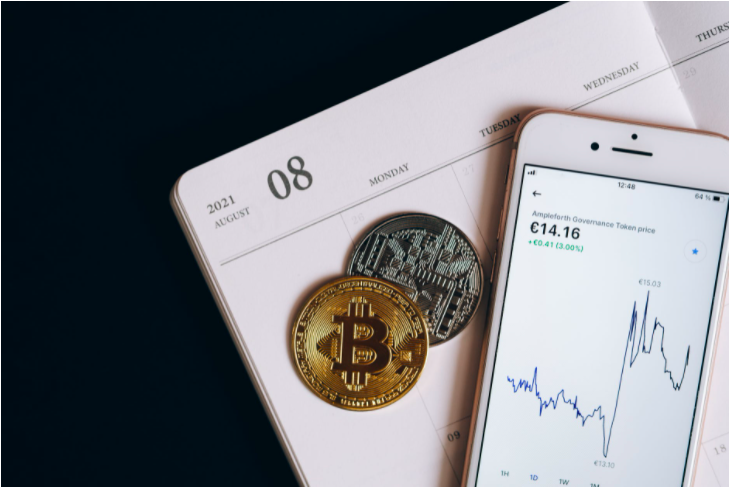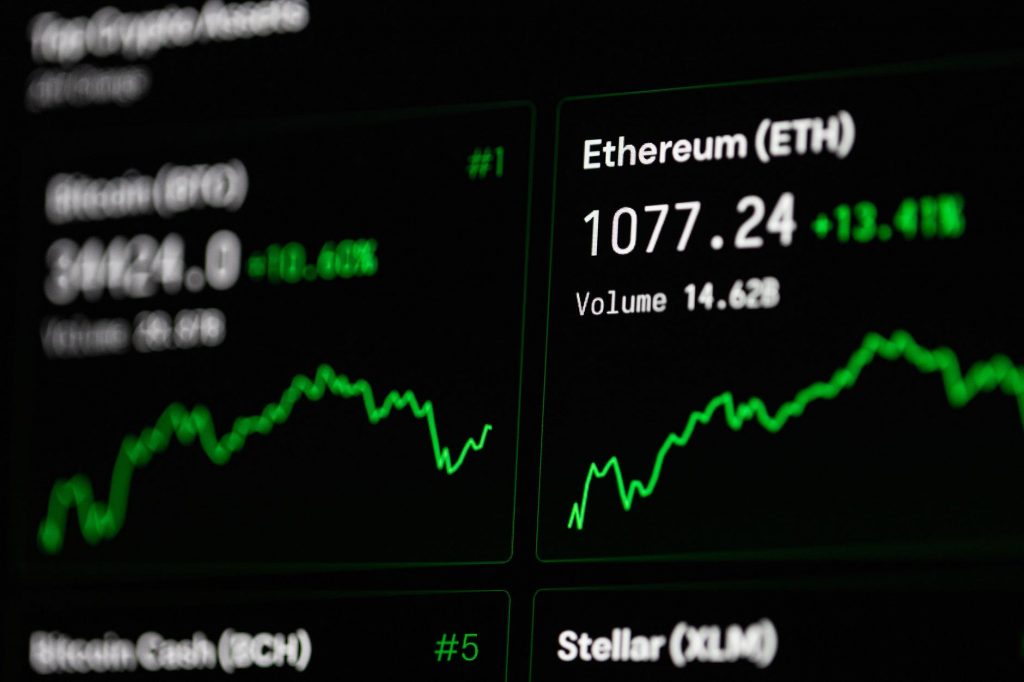Crypto Futures Trading



Crypto futures are a rapidly growing sector of online day trading. They offer a straightforward way to speculate on the cryptocurrency markets. In this tutorial, we explain how crypto futures work and explore the best strategies and trading tips. We also list the top cryptocurrency futures brokers and platforms in 2025.
Best Crypto Futures Brokers






Crypto Futures Explained
As the name suggests, crypto futures are cryptocurrency-based derivatives. They are used to speculate on the expected price of Bitcoin, Ethereum and Litecoin, amongst other popular tokens. And importantly, because most crypto futures are cash-settled, they allow investors to increase their market exposure without taking ownership of any actual cryptocurrency. They can also often be traded 24/7 through supported brokers and exchanges.
Futures contracts state that the buyer must purchase a specific amount of an underlying asset at a set time for a pre-determined price. Originally developed for traditional commodity markets, like livestock or oil, they allow industry players to hedge against unfavorable price movements.

In the cryptocurrency world, futures are often sold by Bitcoin miners (or equivalent) to guarantee good returns on their mining investments. They can also be used as part of hedging strategies. For example, if a trader assumes a long position in the crypto spot market, they can short its futures equivalent to secure an overall profit.
One of the largest Bitcoin futures exchanges is the Chicago Mercantile Exchange (CME). However, retail investors will be disappointed to learn that relatively few online brokers support crypto futures trading. The top platforms that do are Binance, KuCoin and Crypto.com.
How Does Crypto Futures Trading Work?
Traders rarely need to pay the full value of a crypto futures contract. Instead, investors rely on leverage or margin trading. Margin is held as collateral by the broker and is the amount of capital required to open a position. It is also linked to leverage, which allows you to borrow money against the future price of an asset. For example, a 10% margin means that you can buy a crypto futures contract worth 10x what you actually need to pay. This is equivalent to a leverage ratio of 1:10.
While leverage can be used to make large profits, it also amplifies potential losses. Crypto futures are volatile assets, emphasizing the need for a strict risk management strategy. Binance has limited its maximum leverage on such products to 1:20, with Kraken offering leverage up to 1:50. Crypto futures traded on the CME have a 50% margin requirement.
A range of currencies can be held as collateral when crypto futures trading. On traditional exchanges, crypto futures contracts are traded in standardized amounts known as the contract unit. The CME uses contract units of either 5 BTC or, for a Micro contract, 0.1 BTC. Binance, on the other hand, allows traders to buy contracts worth any value over 5 USDT in increments of 1 USDT, depending on how the contract is margined.
Broadly, there are two types of crypto futures contracts: Perpetual and Fixed Maturity. Perpetual contracts have no expiry or settlement, instead auto-rolling every few hours. A funding rate mechanism paid between long and short positions locks the price to the spot rate. Alternatively, fixed-term contracts are generally settled quarterly or monthly.
Example
Imagine that traders A and B entered a Bitcoin futures position at $30,000 each. With leverage of 1:10, this would require a $3,000 margin. Trader B opts for a long position while trader A decides to go short. The price settled at $35,000 for each contract after expiration. So, trader A must pay the exchange minus the deficit loss ($35,000-$30,000 = $5,000) and trader A makes a profit of $5,000.
Crypto Futures Trading Strategies
There are several strategies to consider when it comes to trading crypto futures:
Cash & Carry Arbitrage
Cash and carry arbitrage exploits inefficiencies in the volatile crypto futures and spot markets. The value of a futures contract is linked to the expected price of the underlying currency at a particular date and time. Often, the expected price is overestimated, meaning that the futures price exceeds the current spot price. In such a situation, the market is said to be in ‘contango.’ As the expiry date approaches, the two prices usually converge to a single value.
The core of the cash and carry arbitrage technique involves opening opposite positions in the crypto spot and futures markets. If the market is in contango, traders will open a short position in the crypto futures market by selling a contract while also buying a set amount of cryptocurrency. This way, traders can profit from a rise or fall in digital currency prices, which reduces the risks. This strategy is successful provided that the futures price is theoretically expensive compared to the underlying cryptocurrency.
This style of crypto futures day trading is designed to make steady returns rather than enormous profits. The potential profit from carry trades is determined by the difference between the futures price and spot price. Traders using this technique should explore the relationship between the value of futures contracts and cryptocurrency spot prices by comparing their relative values over an extended period. Investors should also be familiar with the level of commission charged by their broker per trade as these costs can eat into potential earnings.
Range Trading
Crypto futures markets tend to oscillate within a range rather than follow an overall trend. Range trading aims to capitalize on the small price movements that occur during this phase.
The minimum and maximum values of the range are known as the support and resistance levels. At these levels, the price appears to bounce and change direction. Support and resistance levels are driven by day trading psychology, and often occur at nice round numbers.
For instance, assume that the Bitcoin futures price has struggled to break above the $2,800 mark. As traders notice the pattern, many will open short positions at this level, pushing the price downwards. The more often the price touches support and resistance levels, the stronger it becomes. Many traders prefer to wait until the price has touched a particular support or resistance level twice before labeling it as one.
An important part of range trading is identifying possible breakouts, which is when the price moves strongly outside of the support and resistance levels. Many traders use technical tools and indicators like the ADX Indicator, Bollinger Bands, and the Relative Strength Indicator to anticipate periods of volatility or strong trending behavior.
A simple crypto futures range trading strategy is as follows:
- Step 1: Using technical analysis, decide whether the market is moving sideways or trending
- Step 2: If the market is trading within a range, identify the support and resistance levels
- Step 3: At the support level, assume a long position, setting your stop-loss level to just below this value. Conversely, try to short the market at the point of resistance
- Step 4: Place your profit targets near recent highs, the resistance value, or another important technical level
Pros of Crypto Futures Trading
Advantages of trading cryptocurrency futures include:
- They allow you to profit from the cryptocurrency markets without the hassle of taking ownership of any actual coins
- It is expected that institutional investment in crypto futures will bring stability to an otherwise volatile marketplace
- Bitcoin and Ethereum futures can be traded on traditional exchanges like the CME
- Futures can be used as a hedging strategy for your cryptocurrency investments
- Crypto futures can easily be used to bet on declines in digital currency prices
Cons of Crypto Futures Trading
Potential disadvantages of trading crypto futures include:
- Bitcoin exchanges are decentralized and sometimes unregulated, making them vulnerable to market manipulation
- Trading volumes can be low. As an emerging market, crypto derivatives often lack deep liquidity
- Crypto futures can be extremely volatile

How to Choose the Best Crypto Futures Trading Platform
There are several factors to consider when selecting a platform:
Trading Fees
All brokers charge their clients some form of commission, although the precise amount can vary between platforms. Transaction costs are particularly important for day traders executing multiple trades in a single day.
In crypto futures trading, there are two important types of fees: maker fees and taker fees.
- Maker Fees: Traders pay maker fees when they place a limit order below or above market price. This adds liquidity to the order book, meaning maker fees are generally lower than taker fees
- Taker Fees: These costs are paid when liquidity is removed from the order book through the placing of orders. Taker fees are usually incurred by large market players like hedge funds or investment firms
Popular crypto futures brokers have maker fees starting at around 0.02%. Maker fees can also go as low as 0.0000% for high net-worth ‘VIP’ investors with large trading volumes. Taker fees, on the other hand, typically range from 0.04% to 0.01%.
Aside from the trading costs, some brokers charge deposit and withdrawal fees. These commissions vary between payment methods, so check the broker’s website for more details.
Profits made from crypto futures may be classed as income so you may have to pay trading taxes. The CME’s 60/40 rule, for example, sets out that Bitcoin futures—which are capital assets in the taxpayers’ hands—are taxed as 60% long-term and 40% short-term capital gain or loss.
Leverage
Leverage is often used in crypto futures trading to increase market exposure. Some brokers offer leverage of up to 1:50, making it possible to open a position worth 50x the value of your initial investment. Other brokers offer leverage of 1:20 or less. Leverage on crypto-related products is also sometimes capped by regulatory bodies due to their price volatility.
If used incorrectly, leveraged crypto futures trading can lead to significant losses. As a result, beginners may want to use lower leverages while they familiarize themselves with market dynamics. In addition, stop-loss orders are a crucial tool for limiting the effects of unfavorable price movements.
Product Range
Bitcoin futures are the most popular crypto-related derivative. Nearly all cryptocurrency futures brokers offer this type of contract. For those looking to trade futures based on alternative digital currencies, options are more limited. The CME Group, a traditional futures exchange, now offers Standard and Micro Ethereum contracts, reflecting the growth of the sector.
Demo Account
Crypto futures can be risky trading assets. As a result, many beginner investors use trading simulators to learn how these volatile markets behave and to practice strategies. Demo, or paper trading accounts, come pre-loaded with a set amount of virtual cash and are offered free of charge at most brokers.
Trading Data & Tools
Successful day trading strategies often incorporate technical analysis tools. However, the range of charts, signals, and indicators varies from platform to platform, as does the quality of market data.
Many crypto futures traders get their signals from third-party providers. Popular signals providers offer subscription services that give their customers a handful of trading insights per day.
In addition to signals, free indicators are used by traders to anticipate market movements. Platforms often come with a variety of pre-built indicators which can then be customized. Some of the best technical indicators used in crypto futures trading include Moving Average Crossovers, Bollinger Bands, the RSI, and On Balance Volume.
Algo-trading bots are also becoming increasingly popular with crypto futures investors. The use of automated computer programs can be a good way to make your trading strategy quantifiable and increase the frequency of your positions.
Mobile Trading App
The top crypto futures brokers offer clients a smartphone app, allowing them to monitor and execute trades remotely. Features of a good trading application include:
- Easy navigability and a well-designed search function
- Clean, uncluttered design
- Fast execution speeds
- Interactive charts
- Accurate data
Safety & Security
Before signing up with a new broker, it is worth doing a quick background check on their reputation in the trading community. Always make sure that you sign up with a reliable firm as there are a number of bad actors operating online.
Many traders prefer to use brokers registered with top-tier regulatory bodies like the UK’s FCA, Australia’s ASIC, or the US’s CFTC, as these territories tend to impose the most stringent rules. Regulated brokers usually offer clients negative balance protection, investor insurance, and segregated accounts. Approach offshore brokers without KYC checks with an extra layer of caution.
Note, trading crypto futures in India, Canada, South Africa and Singapore can also be done with regulatory oversight.
Crypto Futures Trading Tips
Here are some of our top tips for trading cryptocurrency futures:
- Learn all you can about the crypto derivatives market through online courses, tutorials, and books. Even a small amount of training can prove beneficial for dummies and newbies. Things to brush up on include futures fundamentals and basic technical analysis tools.
- Manage risk. Crypto futures can be volatile assets, making it important to set stop-loss orders. Traders should also have a sensible money-management system in place, such as the percentage method, in which a set percentage of funds are re-invested each trade.
- Develop a trading strategy. Trading with a strategy can help you avoid making rash, emotional decisions in the market. It can also help you learn more about which decisions are profitable. Some investors find it helpful to keep a trading journal to record their activities.
- Get involved in the crypto futures community. Social media platforms can be great places to meet other traders and pick up tips.
Final Word on Crypto Futures Trading
Trading crypto futures removes the need to take ownership of any physical cryptocurrency, which can be lengthy and potentially expensive. Crypto futures are an exciting new way to trade cryptocurrencies, forming an important part of day trading toolkits. They can be used in a variety of scenarios, whether paired with a direct cryptocurrency investment or as a tool for speculation. Use this guide to get started today.
FAQs
Which Is The Best Crypto For Futures Trading?
Most traders prefer liquid crypto futures markets with high trading volumes. In contrast, some investors prefer to trade more stable cryptos while others look to exploit volatile markets.
Is Crypto Futures Trading Halal Or Haram In Islam?
While crypto spot trading is generally thought to be halal, some argue that derivative products like futures are forbidden under Islamic law. Opinions vary, which makes it important to check the ethics with a religious authority.
What Is The Meaning Of Crypto Futures?
Crypto futures are cryptocurrency-based financial derivatives. Contracts state that the buyer is obliged to pay the seller a set price for a fixed amount of cryptocurrency at a particular date.
Is Bitcoin Futures Trading Profitable?
Bitcoin futures and other crypto derivatives can be profitable if used correctly. However, as volatile assets, beginner traders should use them with care.
What Are The Crypto Futures Trading Hours?
The CME’s crypto futures exchanges are open from 6 p.m. Sunday to 6:45 p.m. Friday, ET. Other platforms such as Binance support 24/7 trading.
